The Bronx Metro-North rezoning is among the first initiated by the city since Mayor Adams took office, and will look to spur development of 6,000 homes around future train stations in Morris Park and Parkchester. The plan is in line with Gov. Kathy Hochul’s strategy to increase housing statewide, with an emphasis on building denser in “transit-oriented” communities.
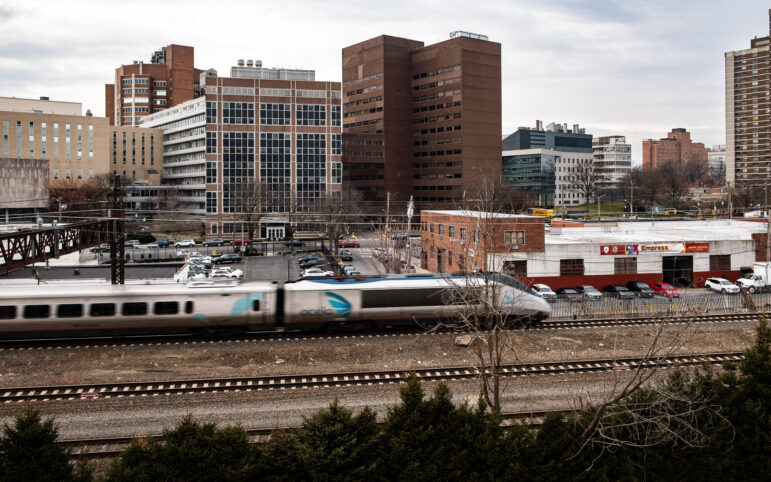
Adi Talwar
A view of the train tracks near the proposed Morris Park Metro-North Station, set to open in 2027.To battle the current housing crisis, Mayor Eric Adams announced late last year his plan to rezone areas of the Bronx for additional housing, specifically looking to spur development around two of four new Metro-North commuter rail stops slated to open in 2027 as part of the Penn Station Access project.
The proposal would rezone an approximately 46-block stretch adjacent to the rail line around the future Morris Park and Parkchester/Van Nest train stations, part of Mayor Eric Adams’ “City of Yes” plan to promote new housing and sustainability. It aims to create 10,000 job opportunities and 6,000 additional homes in the rezoning area, officials have said, with at least a quarter of them income-restricted under the city’s Mandatory Inclusionary Housing (MIH) program.
The Bronx MetroNorth rezoning is among the first initiated by the city since Adams took office, a key part of his “moonshot” goal of building 500,000 new apartments over the next 10 years. It’s also in line with Gov. Kathy Hochul’s strategy to increase housing statewide—what she calls an “an all-hands-on-deck approach”—with an emphasis on building denser in “transit-oriented” communities that are well-served by public transit.
New York City has lagged when it comes to housing production, a dearth advocates say has helped fuel rising rents and a ballooning homeless shelter population. The three Council districts that encompass the Bronx Metro-North rezoning area—13, 15 and 18—together saw just more than 4,500 affordable housing units built or financed within their boundaries between 2014 and 2021, according to data tracked by the New York Housing Conference.
The Dept. of City Planning (DCP) expects public review for the rezoning to begin late this year, a months-long process that allows community members and city officials to weigh in and push for concessions and compromises, culminating with a final vote by the City Council.
“Knowing this community very well, I’m familiar with all the voices—we’re going to have robust conversations and informative debate about how we should proceed,” said Ruben Diaz Jr., former Bronx borough president who is now an executive at Montefiore, which has two medical center campuses along the rezoning corridor.
The rezoning, he added, speaking at a public scoping meeting in January, is a “a unique opportunity of what I’d call, ‘planning with a purpose.’”
“We’re on the cusp,” he said.
Too much, or too little?
Additional housing and other development in Morris Park and Parkchester/Van Nest, supporters say, will capitalize on changes the new Metro-North stations will bring, opening up transit lines and job markets for Bronxites in the area by linking riders to Penn Station and with new connections to Westchester County, Connecticut and other boroughs.
“This is not a chance that comes around very often,” said Logan Phares, political director for the pro-housing advocacy group Open New York, which is pressing the city to expand the area targeted by the rezoning in both geographical reach and density.
“Unfortunately, right now, the proposed scope of the study is just far too limited to meet the scale of the housing crisis and create the housing that we need,” Phares said in an interview with City Limits, pointing to a 2005 downzoning under former Mayor Michael Bloomberg that limited development in a 24-block swath of Morris Park nearby.
That section of the neighborhood, dominated by single-and two-family homes, would remain untouched by the proposed MetroNorth rezoning, which instead targets two slivers of land hugging the existing rail line between Pelham Parkway to the north and East Tremont Avenue to the south, and includes the corridors of White Plains Road, Bronxdale Avenue, Eastchester Road, and Stillwell Avenue.
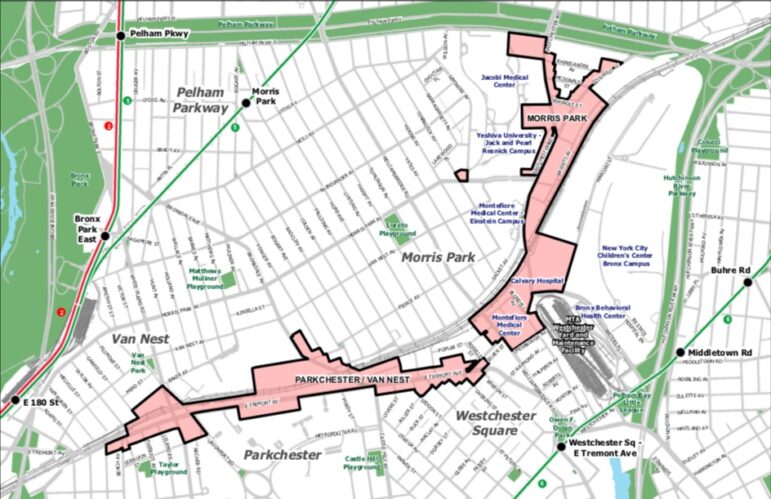
NYC Dept of City Planning
This image has an empty alt attribute; its file name is rezoning-map-771×499.jpeg The pink shows the areas targeted under the proposed Bronx Metro-North study.
“The densities that are presented in the study are just not high enough to address the crisis,” said Phares, adding that Open New York hopes the city will pursue “a significantly more ambitious plan,” than the one currently on the table.
For those wary of the rezoning, however, density is the problem.
“We as community members purchased our house—most of us are lifelong members of this community. We want to live in a low-density area,” Phyllis Nastasio, a member of Community Board 11 and Morris Park resident, said during January’s scoping hearing, echoing similar debates currently playing out across the city and state over Hochul’s Housing Compact plan, which would require cities and towns to hit set development benchmarks.
Carol Douglas, who lives in Castle Hill but works in Parkchester, believes the new Metro-North stations will benefit the community and make her daily commute more convenient. But she was unsure about more development, she told City Limits. “I would love to know, where would they put it?” she asked. “It’s just some kind of overcrowded over here.”
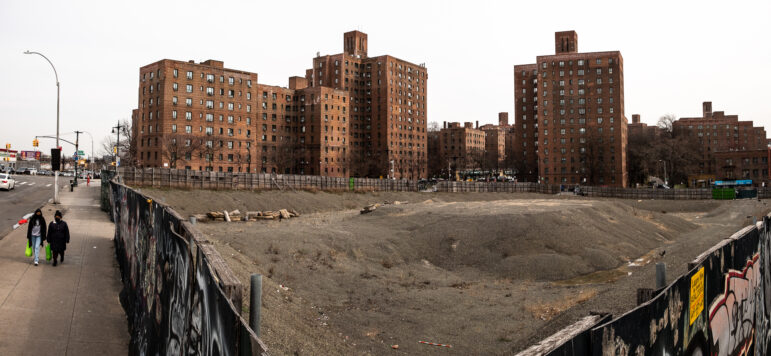
Adi Talwar
A stitched panoramic view of apartment buildings in the Parkchester housing development (located just outside the proposed rezoning area) as seen from East Tremont Avenue near White Plains Road.
If the changes the city is proposing are approved, consultants for the Department of City Planning projected a “worst case scenario” of 60 sites that could be developed in the rezoning area over the next decade, along with another 36 “potential” sites.
“Getting as much benefit as we possibly can”
Part of the city’s public approval process will include preparing an Environmental Impact Statement to assess how the proposed zoning changes would impact local infrastructure.
Bernadette Ferrara, president of the Van Nest Neighborhood Alliance and the chair of Community Board 11, said school capacity is among her top concerns. “We do not have enough middle schools to actually service the families that are in Van Nest, Morris Park, we do not,” she said, saying parts of the neighborhoods are also in need of amenities like grocery stories, pharmacies, community centers and housing specifically for seniors and veterans.
Councilmember Amanda Farías, who represents Parkchester, acknowledged those concerns in an interview with City Limits, saying she’ll push for additional investments for her district as part of the upzoning such as a new school, health care facility, community center or more green spaces. “I don’t think any option should be considered off the table,” she said.
“I don’t necessarily know if any councilmember can say, well, we’re going to vote yes or no this early on in the process, because the point of the process is to ensure that you’re getting community input,” Farías added when asked where she stood on the proposal so far. “I plan to work really closely with our land use division, with City Planning and with community input to make sure that when we vote yes, it’s exactly what the community would like to see coming into the Parkchester area, and we’re getting as much benefit as we possibly can.”
Councilmember Marjorie Velazquez, who represents Morris Park, similarly stressed the importance of robust public input as the project undergoes the city’s land use review process later this year. “And that’s why, when we’re talking about resources, it is really going back to the community and saying, ‘Look, I agree, we’re going to bring in X amount of units that are family based,’” she said.
Velazquez is no stranger to community opposition: Last year, a separate plan in her district to rezone a stretch of Bruckner Boulevard in Throggs Neck to make way for four new, privately developed apartment buildings faced local pushback; Velazquez was herself was initially opposed to the plan, but ultimately voted in favor of its passage last fall.
“I don’t want to displace anyone in my district, and certainly providing housing options that work for them is important,” she told City Limits about the Metro-North rezoning study, which she stressed is still far from finalized and remains “an ongoing conversation of how we can build together.”
“That’s why a lot of these public meetings take place and we always advise it and promote it,” Velazquez said. “People need to understand that their voice matters here, and this is the beginning of many more.”
While City Planning has yet announce a date for when public review for the proposal will officially begin, but residents can sign up to receive updates about future meetings and hearings here.


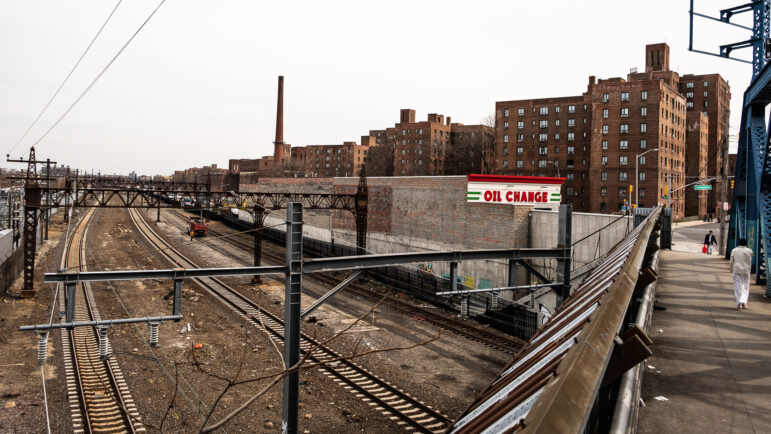
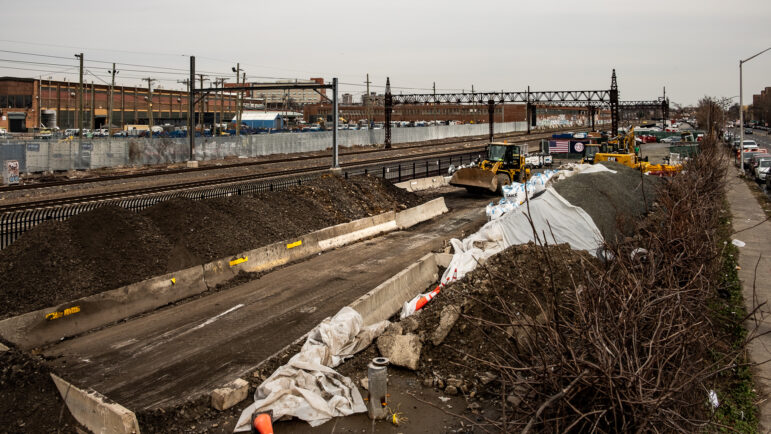

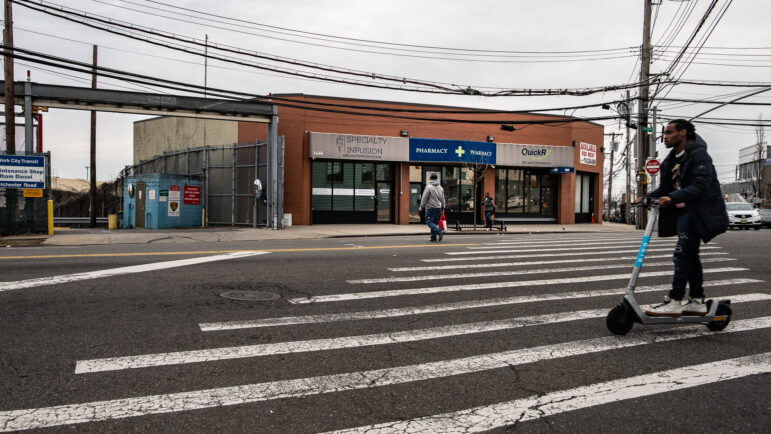
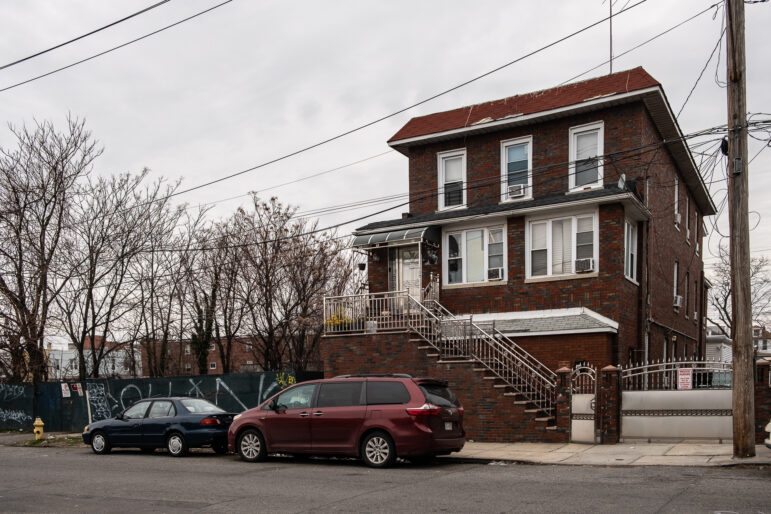







2 thoughts on “As New York Leaders Push for More Housing Near Transit, East Bronx Readies for a Rezoning”
wow thats alot of units being built by these subway stations, i hope it will be plenty of lowincome units and senior units, i also hope that project dont turn into the brooklyn development atlantic yards/pacific park which those units are for high middle income and marketrate, with very little low income and no senior units, so good luck boogie down bronx
It’s actually too modest a rezoning, it should be larger.
Parkchester and Westchester Square have the 6 line on Westchester Avenue in addition. Public transit rich area getting another connection. Upzone along White Plains Road and Castle Hill Avenue to Westchester Avenue at the minimum. Might as extend further east along East Tremont to the 6 at Westchester Avenue too, and west to the district boundary at the Bronx River.
Van Nest has the 5. Should extend north there along White Plains Road minimum. In Morris Park which also has the 5, Bronxdale Avenue and Williamsbridge Road. Across Morris Park Avenue.
Hunts Point MN station will be next to the 2, 5, and 6. This area has a ton of public transportation and should be upzoned. There is no proposal for Garrison Avenue or Bruckner Blvd. Southern Blvd with all the one story shops is another no brainer.
The area where the Co-op City station should be upzoned for more highrises. Allow for residential above the mall like at Queens Plaza.
Rezonings take a lot of political capital, a lot of time, and a lot of money to get done.